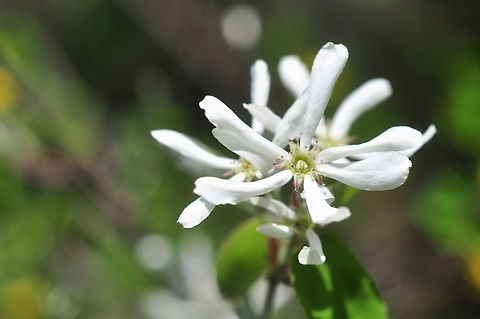
Appearance
There are 25 species of the genus "Amelanchier" reported from the northern hemisphere, and "A. ovalis" is the only naturally occurring species of that genus within Europe. A wide morphological variability has been reported for the flowers and leaves. There are two subspecies which can be distinguished by the number of chromosomes:⤷ the diploid "A. ovalis" subsp. "ovalis"
⤷ the tetraploid "A. ovalis" subsp. "embergeri"
"Amelanchier ovalis" is a thornless, summer-green shrub with an irregular spreading growth. It reaches heights of 3 m, rarely 5 m. The branches are slim and tightly erect in younger growing stages, becoming extended afterwards.
Young shoots are thin and white-haired, older shoots are olive or reddish-brown. The buds have felted hairs which is typical for this species.
The leaves are round or egg-shaped and reach a length of 2 to 5 cm. The top side of the leaves is bald, the underside initially is hairy, but this is lost throughout the growing season.
The white flowers, which are herbaceous, develop lateral and terminal from previous years branches between April and May. The flowers build 3 to 8 erect inflorescences at the end of the shoots.
The fruits are small and spherical, ripening between July and August. When ripe, the fruits become black and contain only a small amount of flesh.
Distribution
"Amelanchier ovalis" can be found in prealpine and submediterranean climates reaching from colline to sub-alpine zones. The most southern place with recorded plants is in Morocco, the most eastern place is in Azerbaijan and the Caucasus. Plants have been observed in the Valais in Switzerland at an elevation of 2,000 m, and in the Atlas Mountains at 2,800 m."A. ovalis" prefers sunny, dry steep slopes, light oak and pine forests and semi-dry grasslands. It grows well in south-facing positions, on rocks with calcareous substrates.
Habitat
Due to its pioneer features, "Amelanchier ovalis" is able to establish on nutrient poor and stony substrates, and can stabilize soils. For this reason, this species is used for land restoration, afforestation or reconstruction of habitats."Amelanchier ovalis" is an important food source for different insect species providing nectar. The plants are dependent on insect pollination, because self-pollination is inhibited by early ripening of stamens.
In a higher phenological stage of the plant, when plants have built ripe fruits, they are often eaten by birds or mammals. Through that, seeds of "A. ovalis" are dispersed by these animals. Depending on the location "A.ovalis" can propagate vegetatively via root shoots.
References:
Some text fragments are auto parsed from Wikipedia.